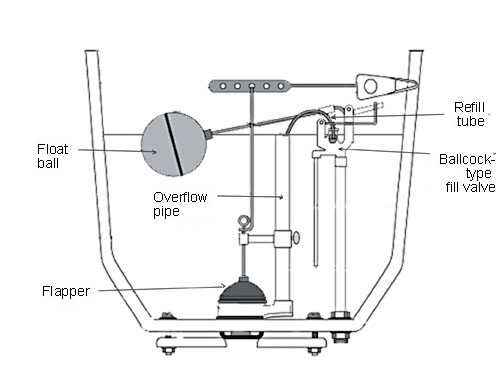Are you familiar with the sound? You flush the toilet, walk away, only to still hear it running ten minutes later. What gives? A running toilet is a common household problem, keeping homeowners awake at night and wasting water constantly. Luckily, using a step-by-step approach can help you isolate the issue and correct the problem quickly.
Know Your Toilet Components
 As with any household problem, the first step is becoming familiar with the item and how it works. Flushing the toilet while watching inside the tank a few times will help you identify the system inside your toilet. Pay attention to how the flapper is lifted by a chain when you flush (push the handle). The water rushes out of the opening in the bottom of the tank, and the flapper lowers to cover the opening. The float monitors water entering the tank, based on its position floating in the water. Try comparing your running toilet to another toilet that works properly. By knowing your toilet, locating the source of the problem will be easier.
As with any household problem, the first step is becoming familiar with the item and how it works. Flushing the toilet while watching inside the tank a few times will help you identify the system inside your toilet. Pay attention to how the flapper is lifted by a chain when you flush (push the handle). The water rushes out of the opening in the bottom of the tank, and the flapper lowers to cover the opening. The float monitors water entering the tank, based on its position floating in the water. Try comparing your running toilet to another toilet that works properly. By knowing your toilet, locating the source of the problem will be easier.
Flapper May Be Stuck
So you feel comfortable with the inner workings of your toilet, but it’s still running. Now what? Look inside the tank. Is it full or filling with water? If not, try closing the flapper. Flappers frequently get stuck open, so it might be worthwhile to see if there is a cause for this sticking. Is the chain caught on something causing the flapper to stay open? Is the flapper properly aligned?
Water Valve All The Way On?
Maybe the flapper is working fine, but your water level is just too low. That would keep the float from reaching the proper position to stop the water from running. So, check to make sure that your water valve is on all the way.
Check the Float Level
Still no silence from the running toilet? Try using your hand to pull up on the float. If the water stops running, you need to adjust the float level to stop the tank from filling around an inch below the overflow tube.
Slow Leaks Cause Continuous Operation
If you’ve tried everything above and still cannot stop the running toilet, check for a slow leak. Add a couple drops of food coloring to the tank and wait. If you see the colored water in the toilet bowl after an hour or two, there’s a slow leak between the tank and the bowl. This can be caused by numerous things, but is often simply a leaky rubber flapper that has decayed over time and no longer seals properly. At this point you’re better off just replacing the whole part to ensure proper functioning.
While these steps will typically work for a standard household toilet, complications or additional problems may exist. If you’ve tried everything, but are still suffering through sleepless nights due to your running toilet, it would be best to contact your New Jersey Roto-Rooter to take a closer look at the problem.
